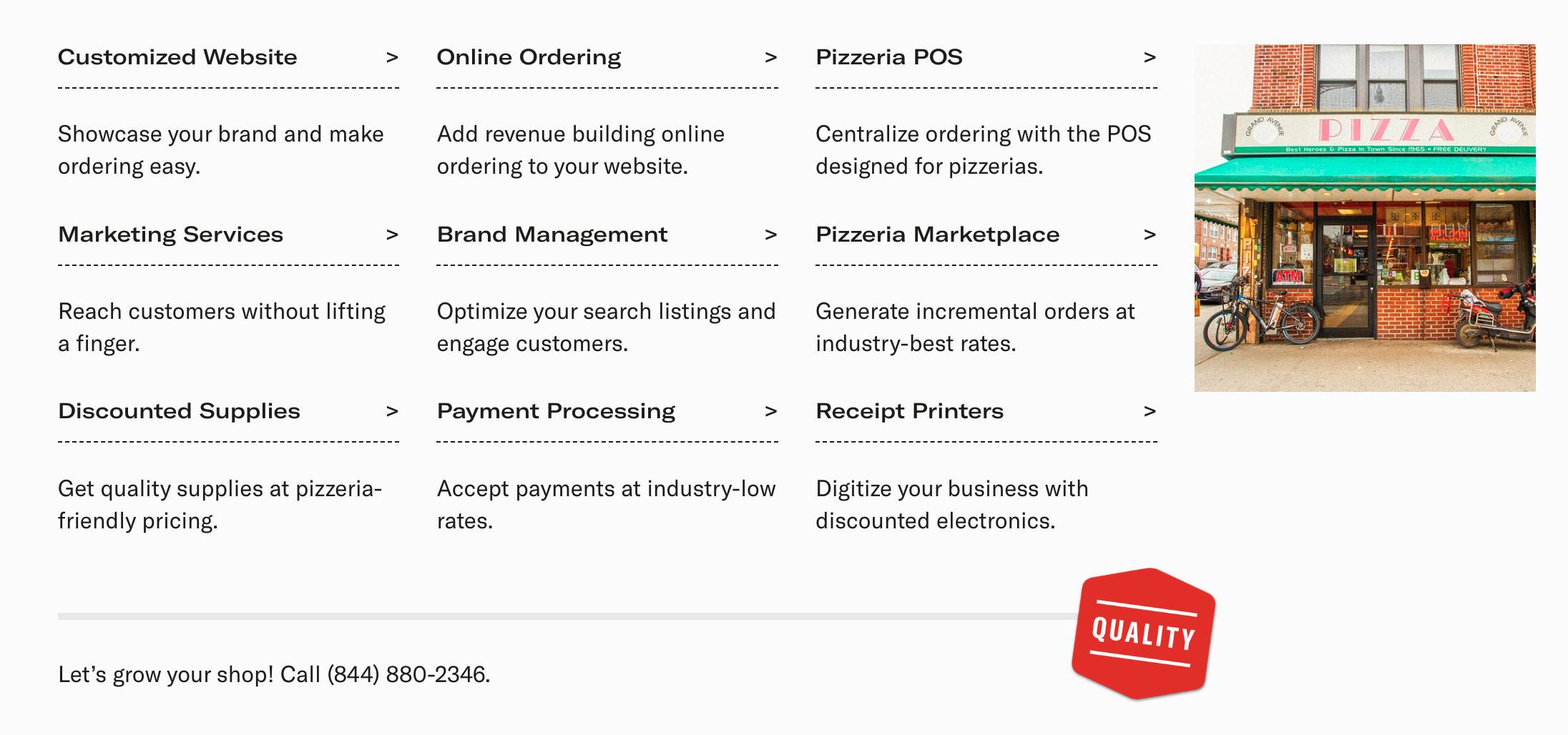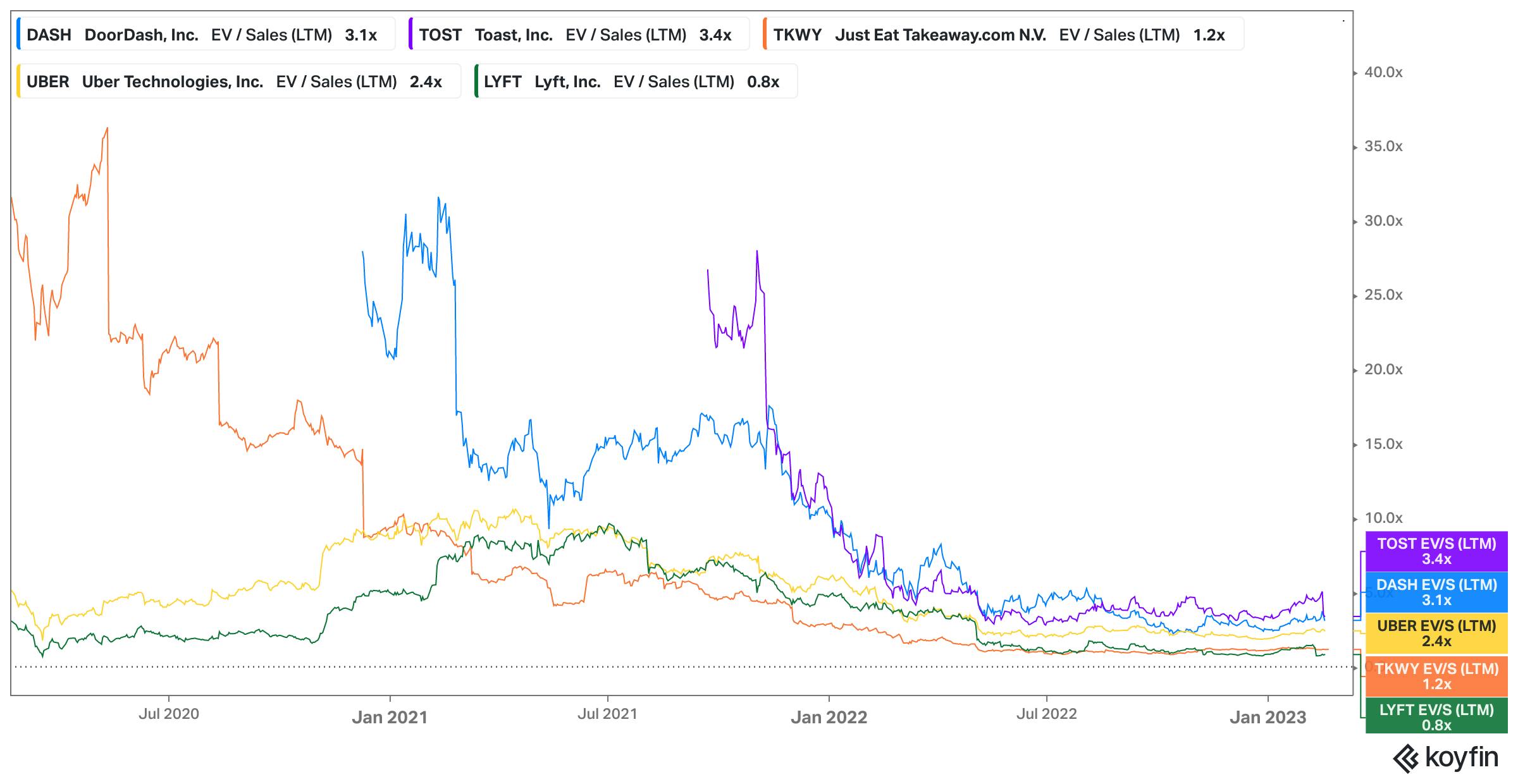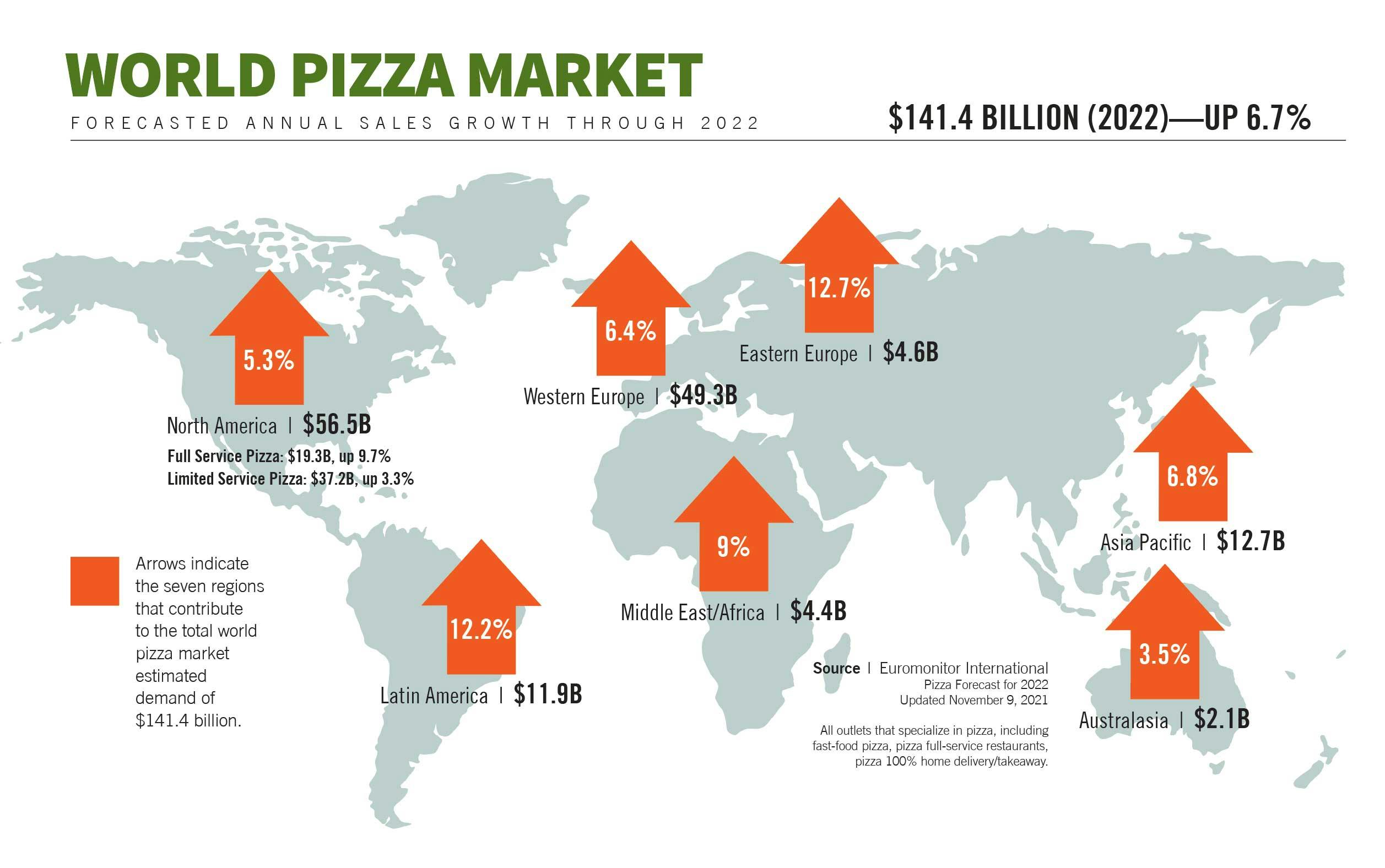Thesis
Pizza is a large and growing market. The worldwide pizza market was estimated to exceed $140 billion in 2022. Of this, the US market makes up ~$45 billion. There are over 75K pizzerias in the US, and each does over $600K in annual sales on average . Of US pizzerias, ~35K are chain stores (such as Pizza Hut, Domino’s, Little Caesars, Papa Johns's) and ~40K are independent pizzerias. While slightly fewer in total number, chain pizzerias are collectively capturing more revenue than the independent pizzerias in the US. An average independent store did $451K per store in annual sales, while an average chain store did $783K in 2021.
As the larger chains embraced technology, adapted to changing consumer preferences, and began to offer online ordering, mobile apps, and digital payments, they began to eat away at the market share of smaller independent pizzerias. From 2006 to 2016, independent pizzerias lost 21% of their market share to larger chains, and about 8K independent pizzerias closed down. Independent pizzerias do not have the economies of scale, technology, financing, or sophistication to run the business as efficiently and profitably as the chain locations.
Slice empowers independent pizzerias with the modern tools that have allowed major pizza chains to dominate. With a suite of products such as online ordering, a website builder and marketing services, Slice enables independent pizzerias to increase average order values, acquire and retain customers, and modernize workflows to run the business more efficiently. The company seeks to position itself as a mission-critical OS for independent pizzerias and has helped over 19K businesses in 3K cities, forming the nation’s largest pizza network — more than double the US footprint of Domino’s.
Founding Story
Slice was founded by IIir Sela (CEO) in 2010. Sela’s family comes from a small town on the Macedonia-Albania border called Debar. The town did not have a traffic light, but it did have a high density of pizzerias (5 pizzerias for a town of only 15K people). Immigrants from Debar have started several pizzerias in America. When Sela was 10 years old, the family immigrated to the US in the 1970s, and he lived on Staten Island surrounded by pizza. His grandfather, uncle, and father operated pizzerias in Manhattan in the 70s, and he had countless friends and extended family members who were also owners of small, independent pizzerias.
In 2003, Sela launched his first company, Nerd Force, after getting a computer science degree from the City University of New York-College of Staten Island. Nerd Force was a web design company that later became a tech services firm that sent IT support representatives around in yellow vehicles. In 2008, he sold Nerd Force for $500K.
Growing up, Sela saw how small pizza operations struggled to compete with large, national chains like Domino’s and Pizza Hut, especially as they began to offer online ordering. The small pizzerias weren’t tech-savvy enough to build in-house online ordering systems. He knew selling digitally would help pizzerias increase average order values by upselling higher-margin items and offering loyalty programs based on customer data.
Sela used the money from the Nerd Force sale to start MyPizza in 2010 to help independent pizzerias sell digitally over websites. He charged far less per order than the third-party delivery players. His first customers were his brother-in-law, cousins, and friends. Sela said AOVs increased from $18 over the phone to $30 on MyPizza. To acquire more customers, Sela wrapped advertising banners around a car and parked the car in front of pizzerias that he wanted to come onto the platform. With this guerilla marketing approach, MyPizza, rebranded as Slice, grew to over 80 restaurants in New York with minimal costs. MyPizza was doing $40 million in pizza orders in 2015 when it raised seed funding.
Product

Source: Slice
Online Ordering and Customizable Website
Online orders are typically twice as large in dollar terms as walk-in orders and are much more efficient for staff to work on. Slice integrates ordering into a pizzeria’s existing website while providing ordering buttons that fit customers’ branding. For pizzerias that do not already have a website or want to create a new one, Slice makes it easy to create a digital storefront from which customers can order easily. It also supports pizzeria owners in website building, allowing them to create new websites in 24 hours or less.
The website supports complex pizza-specific menus with customization levels on both desktop and mobile. Pizzerias can accept digital payments over these websites and support multiple payment methods. They get a dashboard that offers control over menu management, order management, and analytics, making it easy for owners to manage their businesses from any location.
Pizzeria Marketplace
Slice's marketplace connects customers with independent pizzerias in their local area. For the pizzerias, this creates another digital channel to be discovered by customers.
The marketplace makes it easy for customers to find and order from their favorite local pizzerias. Customers can enter their zip code or address and the platform will show them a list of local pizzerias that are available for delivery or pickup. They can browse menus, read reviews, and place orders. They save favorite pizzerias and re-order from them quickly and easily.
Additionally, the marketplace includes marketing tools that help pizzerias attract new customers and retain existing ones. These tools include targeted email campaigns, social media advertising, and customer loyalty programs.
Pizzeria Point-of-Sale & Payment Processing
Slice’s POS offering is called Slice Register. It comes with a register, a receipt printer, a card terminal, a cash drawer, and a kitchen order printer. This allows pizzerias to digitize their in-store operations, allowing for taking orders in-person, on the phone, or online, all from a single screen. With all the orders centralized in one place, it becomes easier for pizzeria owners to get more accurate analytics and have streamlined workflows. This enables the staff to take orders less on the phone and eliminate mistakes caused by handwritten orders and tickets. The POS also integrates with other third-party delivery systems to help pizzerias have a holistic view of their orders and customers.
It negotiates the lowest rates it can, works with the payment vendors, and passes those savings to its customers to help get lower payment processing costs that eat into margins.
Marketing Services and Brand Management
Slice helps pizzerias with automated marketing to help build relationships with customers to drive repeat orders. It sends push notifications that nudge customers at the moments when they are most likely to purchase to proceed with making a purchase. Pizzerias get reporting and analytics on marketing campaigns. Slice also optimizes search listings on Google, Bing, and Apple Maps to expand customers’ reach.
Discounted Supplies
Slice uses its scale to buy supplies in bulk at the lowest prices and passes those savings on supplies onto the pizzerias on the platform. Slice allows for easy ordering and seamless delivery (in New York, New Jersey, and Philadelphia) of the supplies that every pizzeria needs, such as pizza boxes, paper bags, pepper packets, parmesan packets, and more.
Market
Customer
Slice serves independent pizzerias and their customers. These pizzerias are typically small, locally owned businesses that operate in a single neighborhood or community. Slice's platform helps these businesses compete with larger chains by providing them with the tools they need to offer online ordering and delivery with the goal of leveling the playing field between small pizzerias and national chains.
The consumers who buy pizza on Slice are typically residents who want to support small businesses in their community. These customers value the quality and authenticity of the food offered by independent pizzerias, and they appreciate the convenience of being able to order online. They also appreciate the personalized service and sense of community that they get from supporting local businesses
Market Size
The US pizza market is ~$45 billion. There are over 75K pizzerias in the US, each doing an average of over $600K in annual sales. There are ~40k independent pizzerias. An average independent store did $451K per store in annual sales in 2021.
Competition
Food delivery giants like Doordash*, Uber Eats, and Grubhub compete with Slice through their delivery offerings. The pizzeria market is unique in that over 80% of pizzerias on Slice’s platform have their in-house delivery system with delivery drivers already set up. Slice does not need to build a delivery network and focuses on being an operating system for the pizzerias. The delivery players compete with Slice on demand generation for the pizza shops.
Slice is an industry-focused company, but it competes with online ordering and POS offerings of horizontal restaurant management companies such as:
ChowNow - ChowNow powers branded online ordering systems for independent restaurants via the restaurant’s websites, on Facebook and Google pages, through ChowNow-created apps, and via ChowNow’s website, providing the restaurant with customer insights and marketing support. It was founded in 2010 and has raised $64 million in funding. As of July 2022, ChowNow said it had over 22K customers across North America.
TouchBistro - TouchBistro is an iPad-based restaurant point-of-sale system enabling owners to manage reservations and take orders instantly. It was founded in 2010 and has raised $320 million in funding. TouchBistro has deployed more than 64K terminals that provide online ordering, menu and delivery management, contactless payments, marketing, and customer engagement tools.
LunchBox - Lunchbox is the only all-in-one online ordering and guest engagement system for enterprise restaurants. It allows restaurants to build ordering experiences on their websites and apps. It was founded in 2019 and has raised $72 million in funding. As of August 2022, it has worked with over 5K restaurant locations across the US.
UpServe - UpServe is an iPad point-of-sale for restaurants, cafes, salons, spas, retail shops, studios, and other local businesses. It was founded in 2009 and has raised $40 million in funding. Lightspeed POS acquired Upserve to expand its presence in the restaurant industry for $430 million.
Toast - Toast is an all-in-one point-of-sale and restaurant management for restaurants. It was founded in 2011 and has raised $962 million in funding. It went public in 2021. It has its offering in 79K locations. It helps restaurants with online ordering, delivery tracking, reporting, multi-location management, inventory management, and customer engagement. Toast also offers hardware such as a POS, self-service kiosk system, and kitchen display system.
Business Model
Slice charges $2.25 per order. When a customer orders through Slice, the pizzeria pays Slice a $2.25 commission fee for each transaction. In October 2020, Slice announced that it would remove this fee on orders under $10, enabling customers on Slice to keep more of the revenue on these small orders.
Slice also offers advanced marketing offerings, such as advertising campaigns for $500 each, direct mail advertising for $0.05/mailer, scannable menu cards for $0.08/menu, promo code flyers, pizza box stickers, and QR codes, or all of the above for $500/month for 3 months. It also offers an optional $99/month product for listing management and SEO services.
Slice allows pizzerias to buy supplies in bulk, which can save the pizzerias money and serve as an additional revenue stream for Slice. Slice Register, the POS product, likely costs an upfront fee and charges a 2.5% fee on transactions it processes.
Slice's business model is designed to be flexible and customizable, allowing pizzerias to tailor their package to their needs and budget.
Traction
Slice currently serves over 19K pizzerias in all 50 states and about half of the 2.8K pizza shops in New York City. Slice claims that it’s saved these pizzerias over $265 million. Sela also mentioned that revenue had surpassed the $100 million mark in February 2022. More than $1 billion in pizza sales have been made through the Slice platform.
Valuation
In April 2021, Slice announced that it had raised a $40 million Series D at an undisclosed valuation led by Cross Creek, with participation from KKR, GGV Capital, and Primary Ventures. To date, Slice has raised $125 million in funding.
Comparable restaurant software and marketplace companies like Toast, Doordash, Just Eat Takeaway, Uber, and Lyft are currently trading between 0.8-3.4x revenue, down from a high for some of these companies of ~30-40x revenue in 2020-2021. Applying a 10x revenue multiple to Slice’s ~$100 million estimated revenue would imply a valuation of ~$1 billion.

Source: Koyfin
Key Opportunities
Digitization
The trend toward digitization in the food industry has been underway for several years, but the COVID-19 pandemic has accelerated this shift. As more consumers have turned to online ordering and delivery to access their favorite restaurants, businesses have had to adopt new technology to remain competitive. As more people have become accustomed to the convenience of online ordering and delivery, companies like Slice are well postponed to help modernize independent food businesses.
Extending Through Value Chain
Slice has an opportunity to extend through the value chain and touch players like ingredient suppliers that serve essential goods to the pizzerias. Slice has already set up a supplies business line where pizzerias can buy bulk from Slice. It could explore building a B2B marketplace connecting suppliers and wholesalers directly to pizzerias so that they will be able to transact with each other in a more streamlined fashion. This will bring it closer to its goal of being a one-stop shop for all business needs while also being able to monetize the transactions that occur on the B2B marketplace.
New Markets
While the company is currently focused primarily on the US market, there is potential for growth in other regions around the world. Almost $100 billion of the $140 billion global pizza market is outside the US. To support this expansion, Slice would need to invest in building its technology infrastructure to support international operations and establish partnerships with local service providers in each new market.

Source: PMQ
Embedded Fintech
Slice has access to transaction data and sits in the flow of funds, which can be leveraged into offering adjacent financial services like lending, payroll, card issuing, insurance, and more. Building an expanded fintech suite of products could yield more value to customers as Slice works towards becoming a true “one-stop-shop” for all business needs. It could sell more products to existing customers, increase average revenue per user, and increase the platform's stickiness.
Key Risks
Orthogonal Business Models
The food delivery players, such as Grubhub, DoorDash, and Uber Eats, have more resources to invest in customer acquisition. They can offer lower prices or more generous promotions, which can be attractive to price-sensitive customers. That makes their demand generation highly competitive and valuable for the merchants. They can justify their marginal fees on orders because of their on-demand logistics network, which enables merchants to not invest in technology, consumer experience, or labor to fulfill delivery orders.
Many restaurant management startups and incumbents give away online ordering for free in their subscription bundles and do not charge a fee per order. This makes Slice a more expensive solution on a per-order basis for many restaurants, especially when Slice can’t bring enough incremental demand without cannibalization of the direct traffic to merchants.
Inflation
If food prices continue to rise, it will negatively impact the success of the independent pizzerias on Slice’s platform. An increase in the cost of ingredients could erode profit margins, and price increases could lead to decreased customer demand. If independent pizzerias struggle to maintain profitability or go out of business, this could reduce the number of businesses on Slice's platform. This could also hinder Slice's marketplace. Consumers may be less likely to use Slice if there are fewer pizzerias to choose from and the prices for those pizzerias are higher.
Product Stagnation
Online ordering has increasingly become a commodity feature for larger platforms serving restaurants across all cuisines and market segments. Customer preferences are fast changing, and large food delivery marketplaces are aggressively entering new verticals and geographic and product areas. Slice is going to have to innovate its product suite quickly and solve pizzeria-specific problems that its competitors won't.
Summary
Pizza is a large market, with over 5 billion pizzas consumed annually, making for a $140 billion market. The market is locked in a constant struggle between larger chains and independent pizzerias. Ilir Sela, who grew up surrounded by pizza and pizzeria owners, saw how difficult it was for independent pizzeria owners to compete with rapidly digitizing national chains such as Domino’s. To solve this, he founded Slice, providing independent pizzerias with software tools to better compete with larger chains.
Almost 20K pizzerias in the US are already on Slice, and Slice has significant opportunities to expand its product suite, move into new markets, and benefit from the trend of food ordering coming more and more online. Meanwhile, it must fend off a slew of competitors and navigate a changing macroeconomic environment for food inputs.
*Contrary is an investor in DoorDash through one or more affiliates.






